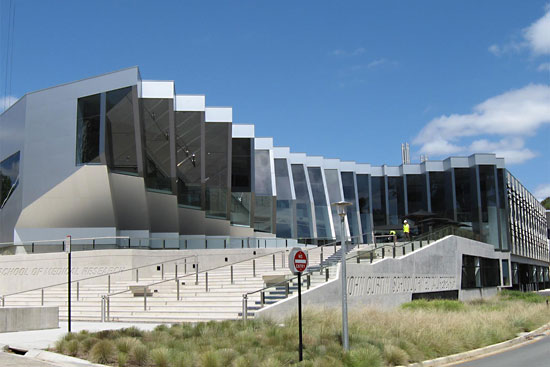ANU: Tree scarring is our signature in the land
Paul Girrawah House rests his palm on the silver-grey bark and speaks in language. House, a Ngambri and Ngunnawal custodian with multiple local Aboriginal ancestries from the Kamberri (Canberra) region, introduces himself to the eucalyptus tree and seeks its permission to proceed with the scarring. He says this is likely the first time tree scarring has been carried out on Country at the ANU Acton campus since colonisation.
“All the land, plants and animals are connected, not just environmentally, but spiritually,” House says. “So before we undertake our work on Country, we seek permission, we give honour to the great spirit Biami, but also honour to the tree. So you form that bond and connection.”
House marks out the shape of a coolamon, a rectangle with curved ends, and gently cuts into the trunk with a sharpened chisel and mallet-modern substitutes for stone tools.
“Tree carving is a part of our identity, our connection to Country and reclaiming of Ngambri (Kamberri) Country. We do it in a respectful way. It’s a patient, polite and gentle way. It’s about taking responsibility,” House says.
House says the name Canberra is derived from the name of his Country and people, the Ngambri, originating from Ngambri (Kamberri) creek flowing through the ANU campus.
A coolamon is a wooden vessel; a traditional implement used by House’s ancestors, especially matriarchs, to gather food and collect water, as well as cradle infants.
“It’s a matriarchal object and paying respect to our matriarchs is a very important part of what I’m doing here,” House explains. He learnt the cultural practice of tree scarring under the guidance of his mother, Ngambri and Wiradyuri Elder Dr Matilda House.
“The passing of our ancestors, our matriarchs and patriarchs, is honoured through the creation and their memory is embedded into the tree and survives for generations and generations.”
Ancestors also cut canoes from trees to cross waterways and fish.
“Trees are so important to Aboriginal culture because they sustain our life in terms of all those good nutrients and provide for our people,” House says.
While cutting coolamons and canoes was the primary purpose of tree scarring, sometimes designs were also carved into the tender, newly exposed trunk. For House, it really “depends on circumstances” and his carvings are about “acknowledging ancestors”. He may return to this tree in coming days to inscribe a pattern.
Keeping culture strong
There are already a number of old growth scar trees on campus, which House describes as “our signature in the land”. They are evidence of Aboriginal statehood, sovereignty and ownership of this landscape he says.
“Carving trees today is about the return, renewal and reclaiming of our identity here on Ngambri (Kamberri) Country, here at ANU. It is keeping culture alive and keeping our people strong.”
Truth-telling is an essential part of voice and treaty House asserts.
“We must remember our ancestors never ceded this Country, it was stolen without consent or treaty and we’ve never been compensated for our losses.”
He commends ANU for understanding the importance of working closely with local people and creating opportunities to share stories of connection to Country.
“I think it’s wonderful ANU is showing an inclusive process of acknowledgement. It’s important for Aboriginal people to reconnect and reclaim Country on our terms.”
Our story is for everyone
Reconciliation is about many things, House says.
“It’s about giving respect, honour and acknowledgement to all people. It’s about working closely with local people to establish relationships and take action.”
But respect is particularly crucial.
“For people who get to walk around the ANU campus and see some of my works here on Kamberri Country it’s about respect. It’s about letting people know that we’re still here. We haven’t become extinct. We still have an identity and connection to Country.”
When people come across these scar trees, House also hopes they see them as an invitation to learn about First Nations’ stories.
“One of the main purposes of carving trees is to share our stories with non-Aboriginal people on Country. We’re proud of that connection to Country and the story we have to share is for everyone.”

